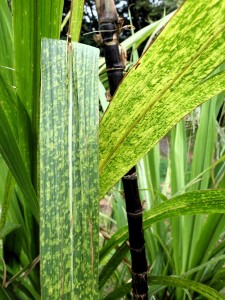Sugarcane Mosaïc Virus (SCMV) detection
 Sugarcane Mosaic virus is a 750 nm long filamentous flexuous particle of the potyviridae family (Potyvirus). This virus infects most exclusively members of the Graminae like sugarcane, maize, sorghum, wheat, rice, etc. It is transmitted by aphids through feeding in a non-persistent manner. SCMV is more readily transmitted to or from hosts such as maize and sorghum than to or from sugarcane.
Sugarcane Mosaic virus is a 750 nm long filamentous flexuous particle of the potyviridae family (Potyvirus). This virus infects most exclusively members of the Graminae like sugarcane, maize, sorghum, wheat, rice, etc. It is transmitted by aphids through feeding in a non-persistent manner. SCMV is more readily transmitted to or from hosts such as maize and sorghum than to or from sugarcane.
Symptoms on infected plants are easily recognizable: the plant develops general chlorosis, mosaic on the leaves and sometimes yellow streaks all along the veins. Depending on time of infection, there may be severe stunting of the plant. Indeed, young plants are more susceptible to infection than mature one. On certain plants approaching maturity, the foliage can turn purple.
SCMV is closely implicated in the Maize lethal necrosis (MLN) disease which is caused by the combination of Maize chlorotic mottle virus (MCMV) and a potyvirus, commonly the Sugarcane Mosaic Virus (SCMV) on maize. Disease incidence is highest where vector populations are high, and susceptible varieties are cultivated in large scale, like in Africa for Maize.
Available kits for the detection of ScMV
Every capture and detection antibodies used in following tests are polyclonal.
Complete ELISA kit : Pathoscreen®
For Double Antibody Sandwich (DAS) ELISA
Capture and detection antibodies: Polyclonal
Reagent set
For Double Antibody Sandwich (DAS) ELISA
Detection or coating antibodies
Only SRA (DAS Double Antibody Sandwich -ELISA)
Conjugate antibodies
Only SRA (DAS Double Antibody Sandwich -ELISA)
Positive and negative controls are available.
Nota Flashkit® : For Sugarcane Mosaic Virus you can use Potyvirus Flashkit®.
(Image Copyright© Scot Nelson)



